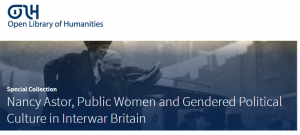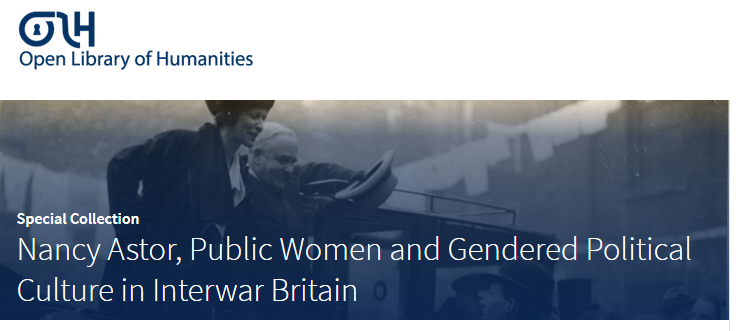We are delighted to announce a new article by Krista Cowman in the long needed ‘go to’ collection on Nancy Astor that is now live at the Open Library of Humanities. The Special Collection is edited by Dr Daniel Grey (University of Hertfordshire) and Dr Jacqui Turner (University of Reading). Daniel Grey is Head of History at Hertfordshire and has published extensively on women, crime and the state. Jacqui Turner is Associate Professor of Modern British Political History and curator of the national Astor100 centenary programme.
Articles will be added on an ongoing basis – keep an eye on this space and the list of articles and abstracts below.
2019 marked the centenary of Nancy Astor’s election to the British Parliament becoming the first woman to take her seat and thus changing democracy forever. Astor was ‘An Unconventional MP’ and this collection considers the parliamentary politics and the gendered culture of the early C20th in which she operated. It engages with ways in which history has influenced the present, conceptualising a ‘future’ grounded in the gendered restrictions of the past. It considers how the identities of Astor and other women were constructed and deployed and how her career has generated gendered discourses on government, citizenship and transformation. This special collection is eclectic in its contributors and contributions; articles address a range of approaches to Astor and her period – new perspectives on Astor, and beyond engagement with Astor as an individual, consideration of issues of gender identity, difference and representation. They provide a new voice and a new legacy.
Collection launched: 06 Jul 2020

06/10/2020: Krista Cowman, ‘A Matter of Public Interest: Press Coverage of the Outfits of Women MPs 1918–1930’ here
Abstract: This paper considers media coverage of the clothes chosen by early women MPs. Opening with the very recent case of public outrage sparked by the dress choice of Labour MP Tracy Brabin, it suggests that a disproportionate attention to what women wear in Parliament rather than what they do there is a longstanding phenomenon. Looking at examples from the 1920s, the first decade of women MPs, it demonstrates how political women have consistently been described in terms of their appearance much more than their policies. The article considers the extent to which a tendency to present women MPs as a unified group added to this, and the challenges of agreeing on a suitable feminine parliamentary dress code as well as a landmark legal case which viewed their dress as a matter of legitimate public interest.
How to Cite: Cowman, K., 2020. A Matter of Public Interest: Press Coverage of the Outfits of Women MPs 1918–1930. Open Library of Humanities, 6(2), p.17. DOI: http://doi.org/10.16995/olh.583
21/09/2020: Helen Glew, ‘In a Minority in Male Spaces: The Networks, Relationships and Collaborations between Women MPs and Women Civil Servants, 1919–1955’ here
Abstract: This article outlines the relationships developed between women civil servants and women MPs between 1919 and 1955. It demonstrates the various ways in which a considerable number of women MPs supported efforts by women civil servants to achieve equal employment conditions with men. Arguing for the importance of networks and organisations embedded in the women’s movement, this article contributes new dimensions to our understanding of both the work of women MPs and the operation of interwar feminist campaigning.
How to Cite: Glew, H., 2020. In a Minority in Male Spaces: The Networks, Relationships and Collaborations between Women MPs and Women Civil Servants, 1919–1955. Open Library of Humanities, 6(2), p.15. DOI: http://doi.org/10.16995/olh.597
21/09/2020: Esther Breitenbach, ‘Scottish Women and Political Representation in the UK and Scottish Parliaments (1918–2020)’ here
Abstract: This article reviews the record of Scottish women’s representation in the UK Parliament since 1918, and in the Scottish Parliament since 1999. Women candidates have stood for election to Westminster at every General Election since 1918, with the first Scottish woman MP being elected in 1923. Subsequently, there have always been women MPs representing Scottish constituencies, with the number increasing in 1997, as elsewhere in the UK. The Scottish Parliament, created in 1999, has consistently seen a higher level of representation of women than that achieved for Scottish MPs at Westminster. The article examines political parties’ track records in promoting women candidates, and comments on the careers of women politicians. The article argues that the increase in women’s representation in recent decades is attributable to the efforts of women activists, and to the specific strategies adopted by parties to achieve this. It also argues that the Scottish Parliament has significantly extended opportunities for women to participate in political decision-making and in policy-making.
How to Cite: Breitenbach, E., 2020. Scottish Women and Political Representation in the UK and Scottish Parliaments (1918–2020). Open Library of Humanities, 6(2), p.14. DOI: http://doi.org/10.16995/olh.579
14/09/2020: Mari Takayanagi, ‘Astor the Fairy Godmother: The Intoxicating Liquor Act 1923’here
Abstract: Before 1923, a teenager could go into a pub at the age of 14 to buy and drink beer; aged 16, he or she could also buy spirits. The Intoxicating Liquor (Sale to Persons Under Eighteen) Act 1923 introduced the principle that people should be aged 18 to drink alcohol in bars, a situation which still exists today. The Act was the first successful private members’ bill from a woman MP, Nancy Astor. Although well-known as a temperance advocate, Astor’s role in this Bill is frequently underplayed, with her husband Waldorf often credited at her expense, and the significance of Parliamentary process not well understood. This paper will examine the background to Astor’s Bill, which emerged from ongoing wartime liquor restrictions, a changing discourse over alcohol and public health after the First World War, and a petition signed by 116,000 teachers. It will analyse the Parliamentary passage of the Bill in the face of die-hard opposition from many of Astor’s fellow Conservative MPs. Although amendments made in committee reduced the impact, this should not detract from Astor’s considerable success in the House of Commons. Astor’s Bill should be better recognised for its long-lasting impact on British society, as a success for temperance campaigners, and as one of the great achievements of Astor’s Parliamentary career. Astor’s Bill was also opposed by Edwin Scrymgeour, Britain’s only Prohibitionist MP, and the paper will consider how his extreme version of alcohol control assisted Astor’s more moderate approach.
How to Cite: Takayanagi, M., 2020. Astor the Fairy Godmother: The Intoxicating Liquor Act 1923. Open Library of Humanities, 6(2), p.13. DOI: http://doi.org/10.16995/olh.567
11/09/2020: Lisa Berry-Waite, ‘I Stuck to Plymouth, Plymouth Stuck to Me’: Nancy Astor, Electioneering and Female Parliamentary Candidacy’ here
Abstract: In November 1919, Nancy Astor won a Plymouth Sutton by-election, becoming the first woman MP to take her seat in the House of Commons. Astor was MP from 1919 to 1945 and won seven elections in total. A vast amount of material has been written on Astor’s 1919 election campaign given its historical significance, but her subsequent elections remain a neglected area of study. This article focuses on all seven of Astor’s election campaigns, exploring how her electioneering evolved over time and the distinctive features of each of her elections. Furthermore, it examines the interconnected relationship between Astor’s gender, class, party, and nationality, and looks at the electability of women more broadly. It argues that all seven of Astor’s election campaigns centred around broad principles of morality, social justice, and her long-standing commitment to Plymouth, coupled with anti-socialist rhetoric. Indeed, Astor presented little in the way of detailed policy plans and promises for the future. Despite standing as the official Conservative candidate, Astor was fiercely independent. She was a politician of conviction who championed issues of personal interest, both to herself and the Plymouth Sutton constituency. Astor’s career as a campaigner is worthy of note given no other female candidate came close to winning seven elections in the interwar period, considering the multitude of obstacles female candidates encountered.
How to Cite: Berry-Waite, L., 2020. ‘I Stuck to Plymouth, Plymouth Stuck to Me’: Nancy Astor, Electioneering and Female Parliamentary Candidacy. Open Library of Humanities, 6(2), p.12. DOI: http://doi.org/10.16995/olh.561
31/08/2020: Dr Anne Logan, ‘MP and/or JP: An Examination of the Public Work of Selected Women during the Early Years of Women’s Enfranchisement (c.1920–1931)’ here
Abstract: The 1919 Sex Disqualification (Removal) Act became law only a year after the first election in which women were able to vote and stand as Members of Parliament (MPs). Among its other provisions, this legislation allowed women to become Justices of the Peace (JPs) for the first time. In December 1919, the Lord Chancellor convened a committee of advisors (the Crewe Committee) drawn from different parts of the United Kingdom and the various political parties, and in 1920 the appointment of the first large group of women to become JPs was announced. Among the early women JPs were several individuals who also feature in the list of the country’s first women MPs, and some others who stood unsuccessfully for parliament. This article concentrates on the careers of a few of these women in public and political service, with particular focus on their engagement with criminal justice reform and connections to the women’s movement. It considers examples both of women who were successful in becoming MPs, and those who were not. Among the issues considered will be the extent of these individuals’ interest in the political and judicial aspects of their work and an assessment of their extra-parliamentary careers. This paper concludes that women could and did lead important and satisfying political lives outside as well as inside the House of Commons.
How to Cite: Logan, A., 2020. MP and/or JP: An Examination of the Public Work of Selected Women during the Early Years of Women’s Enfranchisement (c.1920–1931). Open Library of Humanities, 6(2), p.9. DOI: http://doi.org/10.16995/olh.565
01/07/2020: Professor Pat Thane, ‘Nancy Astor, Women and Politics, 1919–1945′ here
Abstract: Nancy Astor was the first woman elected to the House of Commons, in 1919. She succeeded her husband in his Plymouth constituency when he inherited a seat in the House of Lords, so avoided the discrimination which for decades prevented the selection of many women for winnable seats. She was not a suffragist, or, when elected, a feminist, but the hostility of many men, in and out of parliament, to her presence in the Commons stimulated her support for some, though not all, causes for which the women’s movement campaigned. She promoted equal pay, equal work opportunities, custody rights and the equal franchise, among other things, with some success, but was dubious about divorce and birth control due to her faith in Christian Science and its moral strictures. She was passionately anti-war, so like other feminists and pacifists was an ‘appeaser’. She was not a ‘crypto-Nazi’ as she was, and sometimes is, represented. She facilitated contact between women activists and MPs, male and female, and encouraged cross-party co-operation among women MPs. She was a popular and regular public speaker and widened the appeal of many aims of the women’s movement among women who were dubious about feminism. She was a Conservative who never followed the party line and an active promoter of state welfare measures, especially for young children. She was popular in Plymouth and supported her constituents through World War Two, but stood down in 1945 and left politics when Labour was likely to win the seat in the landslide election. Overall, her greatest contribution is that she significantly raised the profile of women in British politics and assisted the very gradual shift to greater gender equality and expansion of state welfare between the wars and through World War Two.


